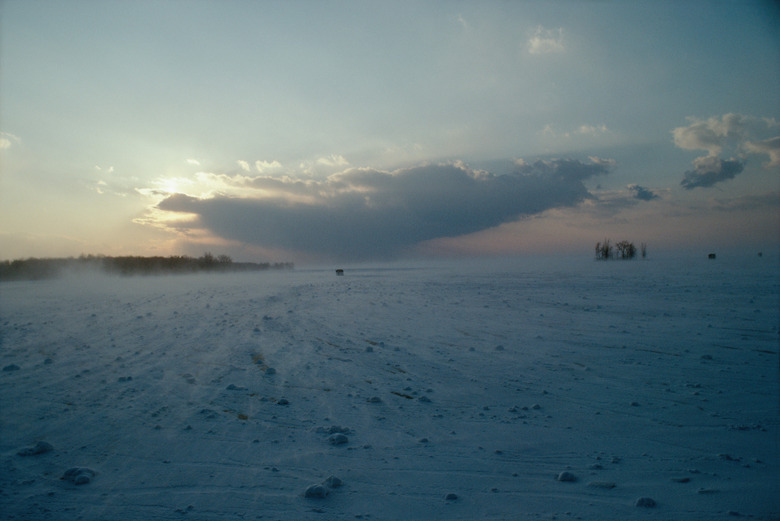What Are Some Natural Environmental Issues In The Tundra?
The tundra biome is the coldest environment on Earth and can found in Europe, Siberia in Asia and across North America. Numerous plants and animals call the tundra home, including lichens, mosses, shrubs, flowers, Arctic foxes, polar bears, caribou, musk oxen, wolves and snow geese. As average global temperature is rapidly increasing, many changes are being seen throughout the tundra. What are some tundra threats?
Climate Change
Climate Change
It's true that climate has changed many times in the planet's history. However, it is the rapid rate of change due to human impacts that people are experiencing today that is the most concerning.
Today, the average surface air temperature in the Arctic is 3.5°C (5.3°F) higher than it was in 1900. By comparison, average global surface-air temperature has only risen by 0.9°C (or about 1.5°F). These changing temperatures have an enormous impact on frozen soils in the tundra.
Melting Permafrost
Melting Permafrost
Permafrost is soil and other matter that is permanently frozen for more than two years at a time. Because of the frozen permafrost layer, the small amount of summer moisture that falls on the tundra is held in the top layer of soil for plants to access. Mosses carpet the boreal forest understory and help insulate the cold soils and permafrost below against warm summer air temperatures.
As climate warms, permafrost has begun to melt. This destabilizes landscapes, which can lead to more landslides, erosion and vegetation change. Permafrost also contains organic matter that has been preserved for thousands of years.
As permafrost melts, the organic matter is exposed and begins to decompose. This process releases carbon dioxide and methane, a greenhouse gas. Both of these products will stay in the atmosphere and contribute to raising the planet's temperature.
Natural Disasters in the Tundra
Natural Disasters in the Tundra
Warming temperatures can also cause tundra adaptations, such as a higher treeline and shrubline. More trees and shrubs means that there is less tundra landscape for smaller plants and lichens. This means less food for caribou and other animals that depend on smaller tundra vegetation.
More woody vegetation and warmer temperatures bring a higher chance of wildfires. Wildfires, which can be started by a lightning strike, are one of the most common natural disasters in the tundra.
In 2007, a fire started in the North Slope of Alaska by a lightning strike and burned for three months, burning 400 square miles. The fire also depleted four centuries' worth of nitrogen stores, which is an important nutrient for plants.
Invasive and Migrating Species
Invasive and Migrating Species
Some species struggle more than others in a changing climate. Farmlands provide food for snow geese which has caused their population to explode and degrade their nesting sites farther north. Their population has increased from around 500,000 in 1965 to potentially 5 million today.
Other animals are also changing territories or experiencing population changes. The Arctic fox is beginning to compete with the red fox after the latter moved north looking for food in warmer climates.
The wolf spider is more successful in warm temperatures and is now able to grow larger. Parasites and disease that can now survive in the tundra cause caribou populations to drop.
Melting Ice
Melting Ice
Though historically there has been ice present in the Arctic year-round, it is estimated by some climate models that the Arctic Ocean will be ice-free in the summer before the end of the 21st century. Sea ice reflects sunlight which helps keep the planet cooler. Without it, warming temperatures will increase even more rapidly as more heat is absorbed by the planet instead of being reflected away.
Tundra Solutions
Tundra Solutions
There are a number of Arctic tundra threats, and the tundra that you see today may look very different in the future. However, reducing the number of fossil fuels people burn will help slow warming temperatures in the arctic and around the planet. Continued research and the increased protection for different species will also help protect this environment.
References
- NASA: Tundra – Mission – Biomes
- NASA: Is a Sleeping Climate Giant Stirring in the Arctic?
- U.S. Energy Information Administration: Arctic Oil and Natural Gas Resources
- Tundra: Life in a Frozen Landscape; Greg Roza
- SeattlePi: Ecological Concerns That Affect the Tundra
- Britannica: Effects of Human Activities and Climate Change
Cite This Article
MLA
Taylor, Lindsey. "What Are Some Natural Environmental Issues In The Tundra?" sciencing.com, https://www.sciencing.com/natural-environmental-issues-tundra-23642/. 28 June 2019.
APA
Taylor, Lindsey. (2019, June 28). What Are Some Natural Environmental Issues In The Tundra?. sciencing.com. Retrieved from https://www.sciencing.com/natural-environmental-issues-tundra-23642/
Chicago
Taylor, Lindsey. What Are Some Natural Environmental Issues In The Tundra? last modified August 30, 2022. https://www.sciencing.com/natural-environmental-issues-tundra-23642/
